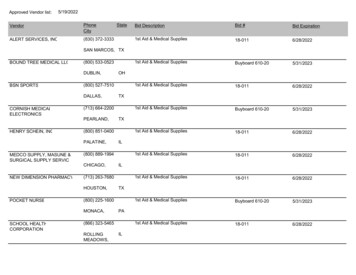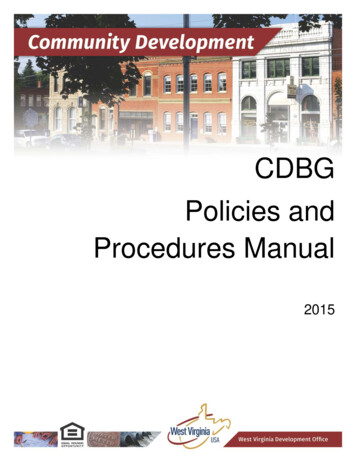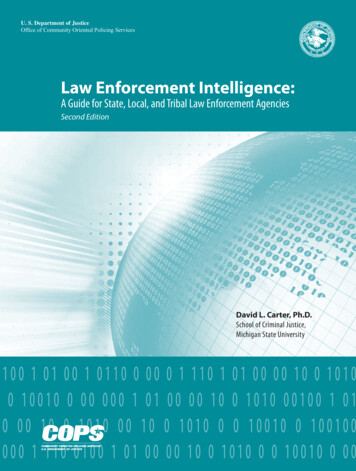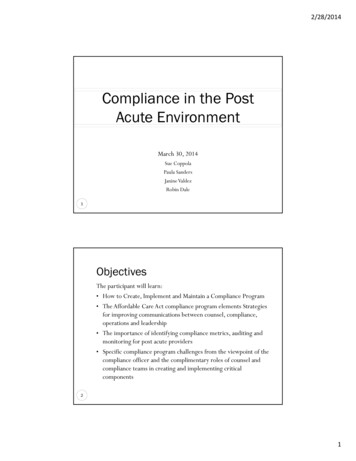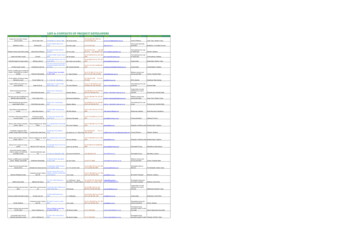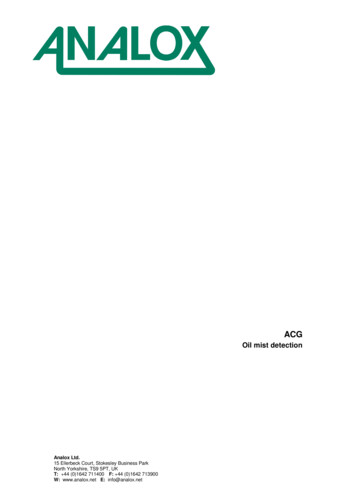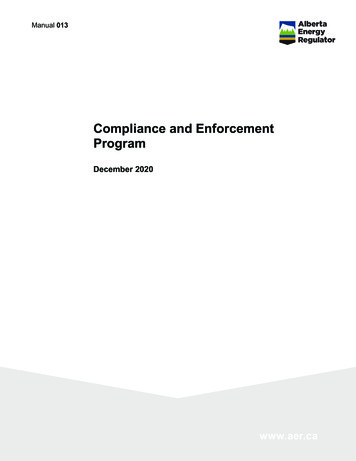
Transcription
Manual 013Compliance and EnforcementProgramDecember 2020
Alberta Energy RegulatorManual 013: Compliance and Enforcement ProgramDecember 2020Published byAlberta Energy RegulatorSuite 1000, 250 – 5 Street SWCalgary, AlbertaT2P 0R4Telephone: 403-297-8311Toll free: 1-855-297-8311Email: inquiries@aer.caWebsite: www.aer.ca
Alberta Energy RegulatorContentsIntroduction. 1Purpose . 112345Compliance and Enforcement Context . 21.1Introduction . 21.2The AER’s Position on Compliance and Enforcement . 21.3Application of the Compliance and Enforcement Program. 2Inspections and Audits . 32.1Introduction . 32.2Planning . 32.3Inspections . 42.4Staff Authorized to Conduct Inspections . 42.5Audits . 52.6Staff Authorized to Conduct Audits . 52.7Transition to Investigation . 5Voluntary Self-Disclosure and Compulsory Reporting . 63.1Introduction . 63.2VSD. 63.3VSD Criteria . 63.4Compulsory Reporting . 73.5Transition to Investigation . 7Responding to Noncompliance. 74.1Introduction . 74.2Responding to Noncompliance . 74.3Communication with a Regulated Party During an Investigation . 8Investigations . 95.1Introduction . 95.2Initiating an Investigation . 95.2.1Triage Process . 95.2.2Emergency Process. 95.3Investigation Priorities. 105.4Issuing a Notice of Follow-Up . 105.5Phases of an Investigation . 105.5.1Evidence Collection . 105.5.2Analysis . 115.5.3Enforcement Decision. 11Manual 013: Compliance and Enforcement Programi
5.66Transparency . 11Compliance and Enforcement Tools . 126.1Introduction . 126.2Notice of Noncompliance . 126.3Warning. 126.4Orders . 136.5Administrative Sanctions . 136.6Fees . 136.7Administrative Penalties . 146.8Prosecution . 146.9Declaration of a Named Individual . 156.10 Civil Court Proceedings . 166.11 Fine and Monetary Penalty Recovery Processes . 166.12 Compliance Dashboard . 167Procedural Fairness . 168Appeals . 17Appendix 1Figure 1.iiDefinitions . 19Responding to a noncompliance . 9Manual 013: Compliance and Enforcement Program
Alberta Energy RegulatorIntroductionEnsuring that regulated parties comply with regulatory requirements is one of the Alberta EnergyRegulator’s (AER’s) principal objectives. This is achieved using various compliance assurance activitiesand by considering the circumstances of each noncompliance.The AER has developed Manual 013: Compliance and Enforcement Program to ensure a fair, protective,credible, effective, efficient, and risk-informed approach that balances the three compliance components:education, prevention, and enforcement.Responding to noncompliance is often a complex and iterative process that requires technical (e.g.,engineering, geological), environmental (e.g., land management, biological), and compliance expertise(e.g., inspectors, auditors, investigators, compliance advisors, legal and statutory decision-makers).Communication as a team about compliance issues and the options to resolve them is fundamental toensuring the best approach and outcomes.The balanced and principled use of compliance assurance activities (e.g., inspections and audits) andenforcement tools (e.g., orders and penalties) demonstrates the AER’s commitment to buildingconfidence through accountable and transparent programs and procedures. This helps make theconsequences of noncompliance consistent, clear, and predictable, and ensures that AER resources aredirected to the highest priorities.PurposeThis manual describes compliance assurance activities and procedures that support the IntegratedCompliance Assurance Framework. The purpose of this manual is the following: Support the organizational culture of compliance assurance within the AER. Support consistent, responsive, coordinated, and effective delivery of compliance assurance activities. Describe this program’s key components and how these components are applied. Provide a foundation within which procedures and operational guidelines can be developed. Promote effective communication and collaboration between AER staff to achieve the best possibleoutcomes. Support operational excellence through continuous improvement, training, and leadership.Manual 013: Compliance and Enforcement Program1
Alberta Energy Regulator1Compliance and Enforcement ContextObjectives of this section:1) To emphasize the AER’s commitment to achieving compliance2) To explain the application and scope of this manual1.1IntroductionThe type and extent of staff involvement in ensuring compliance with AER requirements varies with eachposition and its job responsibilities. AER staff are responsible for conducting verification activities (e.g.,inspections and audits) that might result in the use of compliance or enforcement tools such as a notice ofnoncompliance, an order, an administrative sanction, or an administrative penalty. Collaboration duringverification activities might be necessary to determine the most appropriate response to noncompliance.For example, inspection and audit staff conduct an assessment of the operational, environmental, andsafety impacts and ensure that the noncompliance is addressed, while investigators provide investigativeexpertise. Compliance advisors ensure that staff conducting verification activities (e.g., inspectors andauditors) follow procedures, and otherwise help staff ensure compliance.1.2The AER’s Position on Compliance and EnforcementThe AER strives to ensure continued and lasting compliance with its regulatory requirements. This isachieved through the use of a variety of compliance and enforcement tools.When considering how to respond to noncompliance, AER staff consider the factual circumstances of anoncompliance and the severity of its actual or potential impacts. The compliance history of the regulatedparty is taken into consideration, as well as how to achieve the best environmental, public safety, andoperational outcomes. In some cases, the AER uses additional tools when previous compliance andenforcement tools have been ineffective.The integrity and effectiveness of the regulatory scheme established to achieve the AER’s mandate underthe Responsible Energy Development Act (REDA) is highly dependent on compliance with regulatoryrequirements. The AER will consider an appropriate response to any failure to comply with regulatoryrequirements.1.3Application of the Compliance and Enforcement ProgramThe compliance and enforcement program applies to all incidents of noncompliance with regulatoryrequirements imposed or administered by the AER, including acts, regulations, rules, approvals (asdefined in REDA), directives, directions and orders of the AER, codes of practice, and other regulatoryinstruments.2 Manual 013: Compliance and Enforcement Program
Alberta Energy RegulatorThis manual is not a complete statement of all AER compliance assurance activities and procedures. Inusing this manual, AER staff will need to refer to other business rules, where applicable, that guide otheraspects of compliance management relating to specific compliance program areas.2Inspections and AuditsObjectives of this section:1) To ensure a common understanding of the terms “inspection” and “audit”2) To provide information about the roles and responsibilities of AER staff authorized to conductinspections and audits2.1IntroductionInspections and audits are important functions used to support the AER’s compliance assurance program.Their associated procedures might vary, depending on which AER group is involved, but they are similarin that they are systematic, objective, documented processes and procedures for gathering and evaluatingevidence and for identifying risks that increase the likelihood of an incident or noncompliance; are connected to AER-regulated sites and AER-regulated activities through a risk-informedassessment by AER staff; involve review, where applicable, of documents and observations in the field to gather evidence; can be planned (proactive) or in response to an incident (reactive) that is occurring; and document the results, which are provided to the regulated party.The purpose of both is to verify compliance with the AER’s regulatory requirements.2.2PlanningAER staff verify regulatory compliance through coordinated inspection and audit activities. Criteria thatAER staff consider when planning include operator performance and compliance history, sensitivity of areas where operations take place, inherent risk, and the significance of regulatory requirements.Manual 013: Compliance and Enforcement Program3
Alberta Energy Regulator2.3InspectionsInspections are generally characterized as any field activities carried out to verify compliance withregulatory requirements. Inspections can be proactive (i.e., operation-specific or sector-specific) orreactive. Proactive inspections are generally done by inspection staff and, where applicable, incollaboration with audit staff. They can include field observations and review of the regulated party’s dataor other materials. Reactive inspections can occur in response to information such as audits, incidentnotifications, or complaints that come to the attention of the AER. Inspections can be announced ahead oftime, or unannounced.Inspections may also be used to determine sector compliance rates or to assess risks and to gain technicalunderstanding of new operations, equipment, or processes associated with regulated activities. Inspectionscan also promote compliance by educating the operator. In some circumstances, an inspection willidentify the need for an investigation of noncompliance with regulatory requirements.2.4Staff Authorized to Conduct InspectionsDesignated AER staff are authorized, by AER delegations of authority, to conduct inspections. Staffconducting inspections will conduct themselves in a professional manner. Upon arrival at a regulated site,facility, or other associated location, inspectors should identify themselves; advise appropriate personnel, if present, of the purpose of the inspection; produce an identification card when requested; and identify or explain the nature of the authority that the inspector has and the duties that the inspectorplans to carry out.While conducting inspections, AER staff have authority to do, among other things, the following: Enter any place Make reasonable inquiries of any person Request any information Remove or copy any informationMore information on the powers and duties conferred on AER staff during an inspection are found in theenergy resource and specified enactments located on the AER’s website.Upon conclusion of the inspection, where representatives of the regulated party are present, findings arediscussed, including any particular noncompliance identified or any potential future noncomplianceissues. Inspectors should also acknowledge where excellent performance was identified.4 Manual 013: Compliance and Enforcement Program
Alberta Energy Regulator2.5AuditsAn audit is generally focused on information and data in the possession of, or requested by, the AER.Audits are typically done by analyzing information and by engaging the regulated party and AER staffwhen required. They can also be in response to information from inspections, incident notifications, orcomplaints that come to the attention of the AER. Audits can be announced ahead of time, or they can beunannounced.Audits may be used to determine sector compliance rates or to assess risks associated with regulatedactivities. They can also promote compliance by educating the operator. In some circumstances, an auditwill identify the need for an investigation of noncompliance with regulatory requirements.The following are a few audit examples: Well suspension and abandonment audits ensure that inactive wells have been suspended andabandoned in accordance with prescribed requirements. Approval and licensing audits ensure that the information provided by regulated parties in theapproval process is accurate and that the operations are being conducted as licensed or approved. Emergency preparedness audits ensure that regulated parties have emergency response plans in placeand can adequately respond to emergencies during energy activities. Mineable oil sands and coal scheme approval audits ensure that oil sands mines and coal mines areoperating in accordance with their approval. Flaring, incinerating, and venting audits ensure that flare systems are designed and operatedappropriately and in accordance with approved conditions.2.6Staff Authorized to Conduct AuditsSimilar to AER inspection staff, AER audit staff have the authority under legislation to requestinformation and examine records pertaining to the construction, operation, maintenance, or closure of anenergy resource development.2.7Transition to InvestigationInspections and audits may lead to investigation when noncompliance is confirmed. In these cases, thepurpose shifts from verifying compliance and managing the potential impacts, to collecting informationand evidence to determine the facts relevant to a noncompliance (see section 5).Manual 013: Compliance and Enforcement Program5
Alberta Energy Regulator3Voluntary Self-Disclosure and Compulsory ReportingObjectives of this section:1) To explain the voluntary self-disclosure (VSD) and compulsory reporting processes2) To provide criteria for nonacceptance under the VSD process3.1IntroductionThe AER might become aware of noncompliance by regulated parties through either voluntary orcompulsory reporting of a noncompliance or contravention.3.2VSDVSD is a process by which a regulated party identifies and voluntarily reports noncompliance to the AERwhere reporting of a noncompliance is not compulsory. The AER’s VSD process is intended to encourageregulated parties to proactively identify, report, and correct noncompliant events. When a regulated partyidentifies its own noncompliance, the AER expects the party to correct or address the noncompliance andreport to the AER in writing that it has been corrected or addressed.3.3VSD CriteriaUpon review, the AER will not accept a regulated party’s VSD of a noncompliant event under thefollowing circumstances: The regulated party was not the first party to contact the AER about the noncompliance. The regulated party has not taken the appropriate steps in response to the noncompliance at the timeof disclosure, to the satisfaction of the AER. Notification of the noncompliance occurred during a required performance presentation (e.g., asdefined in Directive 054: Performance Presentations, Auditing, and Surveillance of In Situ Oil SandsSchemes). Notification of a noncompliance occurred in an application to restore compliance. Notification of a noncompliance was given after the AER had started an audit, inspection, orinvestigation. Notification to the AER of an event or a noncompliance is required by an act, regulation, rule, ordirective, or as a condition of an approval. Notification was given to the AER of a noncompliance that the regulated party has already beenrequested to fix. Self-disclosure of the noncompliance will result or has resulted in a competitive advantage.Further guidance on the AER VSD process can be found on the AER website.6 Manual 013: Compliance and Enforcement Program
Alberta Energy Regulator3.4Compulsory ReportingCompulsory reporting refers to the obligation of regulated parties to immediately report contraventions tothe AER as mandated by regulatory enactments such as the Water Act, the Public Lands Act, and theEnvironmental Protection and Enhancement Act. Many operating approvals granted by the AER will alsoinclude this obligation as a condition.The requirement to report a contravention will disqualify a regulated party from the option to voluntarilyself-disclose.3.5Transition to InvestigationA regulated party’s reporting may lead to an AER investigation. If it does, the purpose shifts from theAER managing the noncompliance and potential impacts to collecting information and evidence todetermine the facts relevant to a noncompliance (see section 5).4Responding to NoncomplianceObjectives of this section:1) To ensure fairness and consistency in the assessment of and response to noncompliance2) To provide guidance on when it is advisable to consult with compliance advisors or the investigationteam on a regulated party’s noncompliance3) To provide guidance on when the investigation process applies4.1IntroductionThis section outlines the steps for AER staff to follow when they become aware of a noncompliance froman inspection, an audit, a VSD, or compulsory reporting. Information may also be reported by a memberof the public or other stakeholder; such information is verified by AER staff before the complianceprocess begins.In some circumstances, it is appropriate to consider multiple, concurrent approaches to assessingnoncompliance. For example, a notice of noncompliance issued to address the immediacy of a situationmay be accompanied by an investigation, which can result in the use of an enforcement tool. Applicablelegislation should be reviewed when multiple approaches are being considered.Specific procedures for managing audits, inspections, and noncompliances are not dealt with in thismanual.4.2Responding to NoncomplianceOnce a noncompliance has been verified, AER staff follow the steps below and as shown in figure 1.Compliance advisors are available for guidance.Manual 013: Compliance and Enforcement Program7
Alberta Energy Regulator1) Address the noncompliance. Although typically done through a notice of noncompliance if identified by AER staff, theappropriate compliance tool or process (e.g., the VSD process) is employed to address andmanage the noncompliance, regardless of the noncompliance triage assessment outcome (step 2,below). Manage the file according to the business rules of the AER employee’s specific program area.A file will include systems and procedures for recording inspections, audits, VSDs, compulsoryreports, noncompliance information, correspondence with the regulated party and the party’snoncompliance response, and noncompliance triage assessment decision results.2) Assess the noncompliance using the noncompliance triage assessment. Concurrent with step 1, this is a review of the information available to determine the significanceor impact of the noncompliance. If the review indicates that the noncompliance might require more attention, AER staff are toforward the noncompliance triage assessment to the Investigations Team.3) Upon further review of the facts of the noncompliance triage assessment, conduct an investigation ifwarranted. See section 5 for information on investigations. Investigators are available to all AER staff for consultation to determine whether an investigationis warranted.Use of these steps by AER staff ensures that consultation occurs when required and that thenoncompliance is addressed in a consistent and effective manner across the AER. When a regulated partyfails to come back into compliance or when new information becomes available, the appropriateness ofthe response will be re-evaluated and may change (e.g., AER staff may resubmit the noncompliance triageassessment so the investigation can be reconsidered).The information in this section is not intended to impair the discretion of AER staff to take immediatesteps to remediate a noncompliance.4.3Communication with a Regulated Party During an InvestigationDuring an investigation, it is important to ensure that communication between AER staff and theregulated party does not compromise the investigation—e.g., ensure that evidence is preserved, thatstatements are taken correctly, and that there are no errors that might prevent an enforcement response.Staff should ensure that there is dialogue with the investigator about roles and responsibilities beforeengaging in discussions with the regulated party.8 Manual 013: Compliance and Enforcement Program
Alberta Energy RegulatorFigure 1. Responding to a noncompliance5InvestigationsObjectives of this section:1) To ensure a common understanding of the investigation process2) To provide information about the roles and responsibilities of staff authorized to conductinvestigations5.1IntroductionThe goal of an investigation is to systematically collect information and evidence to determine the factsrelevant to a noncompliance.5.2Initiating an InvestigationThere are two processes by which an AER investigation can be initiated.5.2.1Triage ProcessWhen AER staff identify a noncompliance, they are to consider the noncompliance triage assessment, andif any factor is met, complete the assessment form and refer the noncompliance to the InvestigationsTeam.5.2.2Emergency ProcessWhen an incident occurs that meets the AER incident reporting factors, notification is sent to theInvestigations Team. The Investigations Team reviews the situation report to determine whether aninvestigation is required based on initial evidence of a potential noncompliance.Manual 013: Compliance and Enforcement Program9
Alberta Energy Regulator5.3Investigation PrioritiesA priority is assigned to an investigation to enable informed decision-making to allocate resources forinvestigations. Investigations are prioritized as critical, high, medium, and low and consider items such asthe following: Significance of adverse effects on the environment and on public safety—Protection of theenvironment and public safety is a top priority at the AER. Regulatory confidence—It is important for the AER to maintain industry and public confidence thatthe regulatory process is effective. Expectation for a public report—Energy development in Alberta is of great public interest and thepublic has an interest in being informed of the outcome of investigations. Knowing gain of competitive or financial benefit—If a noncompliance is conducted with intent togain competitive or financial benefit. Behavioural change—At times it is necessary to proceed with an investigation for the purposes of anenforcement response in order to change a regulated party’s behaviour.When an investigation is opened, it undergoes an initial review to further assess the supportinginformation submitted and to prepare an investigation plan. More information is often required todetermine facts relevant to the noncompliance. If it is determined that further follow-up is not warranted,the investigation will be closed. However, an investigation will advance and a notice may be provided tothe regulated party when there is reasonable belief that a noncompliance under the AER’s jurisdiction has occurred, the regulated party has been identified, and no mitigating factors exist at the time.5.4Issuing a Notice of Follow-UpA notice of follow-up is a formal notification sent to the regulated party that the AER will be gatheringfurther information related to a noncompliance.5.5Phases of an InvestigationAfter the initial review, the investigation process at the AER has three general phases.5.5.1Evidence CollectionGather initial evidence to determine whether a noncompliance occurred. This phase can includeconducting site visits, assessing incident response activities, making inquiries, obtaining information from10 Manual 013: Compliance and Enforcement Program
Alberta Energy Regulatorthe regulated party and others, and gathering historical background information. In some cases a courtorder or other form of judicial authorization may be required.Samples can be collected for analysis, and audits can be used to verify the accuracy of informationprovided by the party under investigation.5.5.2AnalysisAnalyze and interpret the information and evidence to determine whether there is enough evidence tosubstantiate a noncompliance and assess due diligence. More information or evidence may be collectedafter the initial information is reviewed.5.5.3Enforcement DecisionThe findings of an investigation are presented to a statutory decision-maker to determine the appropriateresponse. There are no automatic enforcement responses. All available and appropriate tools areconsidered.Nothing in this manual restric
Ensuring that regulated parties comply with regulatory requirements is one of the Alberta Energy Regulator's (AER's) principal objectives. This is achieved using various compliance assurance activities and by considering the circumstances of each noncompliance. The AER has developed Manual 013: Compliance and Enforcement Program
